Chapter 12: The Cognitive Perspective
1/39
There's no tags or description
Looks like no tags are added yet.
Name | Mastery | Learn | Test | Matching | Spaced |
|---|
No study sessions yet.
40 Terms
Lecture Roadmap
1.Basic themes and assumptions
2.Cognitive representation
3.Memory structure & organization
4.Cognition and the self
5.Attributions and decision-making
6.Evaluating the cognitive perspective
Learning Objectives
1.Define schema and script and give an example of each
2.Define semantic memory, episodic memory, and procedural memory and describe the differences between each
3.Describe the difference between explicit and implicit memory
4.Define self-schema
5.Define attribution and describe different attribution biases (e.g., hostile attribution bias)
6.Explain how the Cognitive Perspective relates to our personality
Social Learning Theory
– posits that people learn through observing, imitating, and modeling others' behavior.
◦Includes behaviorism principles but also reintroduces ideas of cognition and internal motivation
The cognitive revolution
an intellectual shift in psychology that started in the 1950s
Focus on studying (scientifically) mental processes
Introduced new subfield: cognitive psychology
Assumptions of the Cognitive Perspective
1.The mind is important! And we can study it
2.People integrate and organize information
3.Personality is reflected in decision-making processes
cognition
Cognition mediates (explains) the effect of personality on behavior

How might cognition influence responses?
Tri-level Framework (Pylyshyn, 1999):
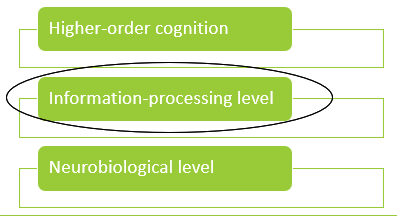
schema
mental organizations of information (knowledge structures)
Types of schemas
person schemas…
Schemata
◦Help us organize information about our world
◦Help us make predictions
◦Provide a basis for action (especially in ambiguous or novel situations)
For example, think about the first college class you ever attended
◦You had never been to college before
◦But you had a schema for “class” from previous school experience
script
a person’s knowledge about the sequence of events expected in a specific setting
a type of schema for events
Cultural schemas
generalized collections of knowledge that we store in memory through experiences in our own culture
e.g. ordering at a restaurant in the U.S. vs. other cultures
e.g., Cultures of Honor and aggression
what is memory
researchers distinguish between several different “types” of memory, which operate in slightly different ways
short-term (working) memory
the information we are actively “working with” or thinking about
memory structure
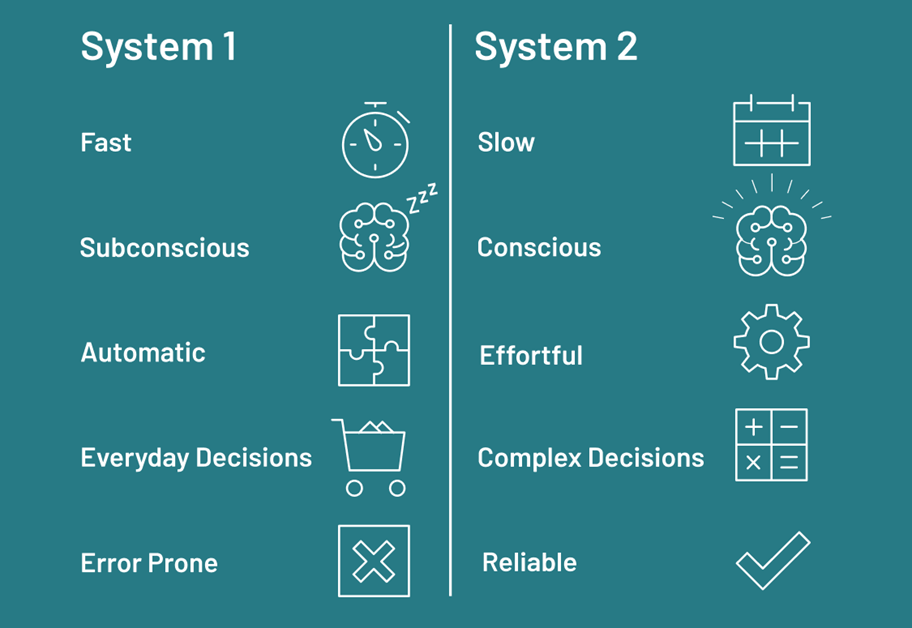
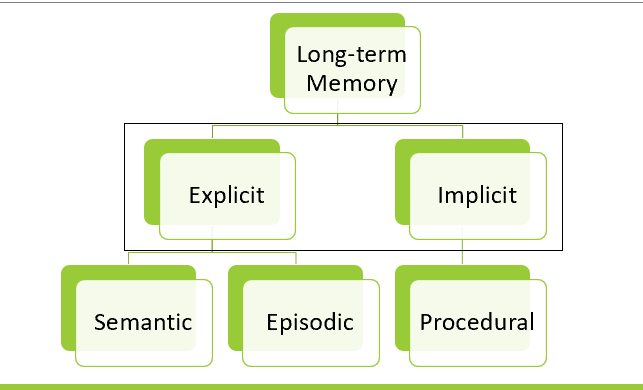
explicit (declarative) memory
conscious, intentional recollection of factual information, previous experiences, and concepts
◦Includes semantic and episodic memories that you can recall
implicit memory
unconscious or automatic memory…
Not always intentionally stored and cannot always be brought into conscious awareness
Includes procedural memory
Includes automatic mental associations
semantic memory
conscious long-term memory for meaning, understanding, and conceptual facts about the world.
episodic memory
memory for events and experiences
prof going to see the mona lisa with her roommate
procedural memory
knowing how to do something
tying shoes, having a song memorized on an instrument
thinking about how to do something explicitly can actually throw you off if you are used to doing it automatically (proven for basketball, sort of like dance choreo)
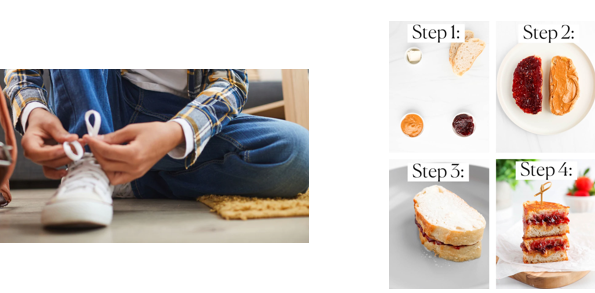
maintaining procedural memories
We can keep our procedural memories, even after loosing semantic and episodic memories (e.g., due to brain injury)
Example: Clive Wearing
Example: Jason Bourne
semantic network model
graphic depictions of knowledge composed of nodes and links that show hierarchical relationships between objects.
this is how long term memories are “stored” in the mind
Priming
exposure to one stimulus may influence a response to a subsequent stimulus
if the concept “orange” is activated, related concepts will temporarily become more accessible in our minds
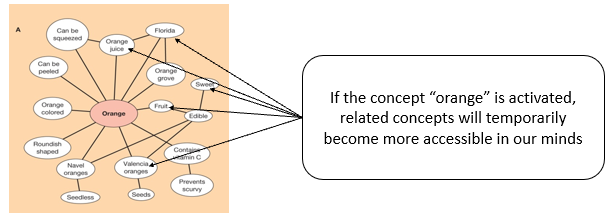
Priming happens at the implicit (non-conscious) level
semantic concepts themselves are conscious
however, the connections/associations between them may not always be
What is in our semantic networks (and connections between them) may give rise to some ____
individual differences
is priming overblown
some research has failed to replicate the walking study (meaning there may not be that big of an effect)
self-schema
cognitive generalizations about the self, derived form past experience, that organize and guide the processing of self-related information

self-schemata drive cognitive processing
for example, people with an independent self-schemata were faster to process words relating to being independent
people diagnosed with clinical depression recalled more negative (vs. positive) self-referential adjectives
negative bias unique to self; did not apply to other domains
You could have a self-schema on any number of possible dimensions
◦Personality traits
◦Abilities for specific domains (e.g., sports, math, reading)
◦Physical health and appearance
◦Opinions and political ideology
◦Cultural identification
◦Etc.
self-complexity
our self-schemas can also be more or less complex
def: having many distinct self aspects
◦May help deal with adversity?
(picture: all are separate items)
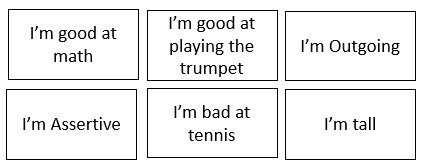
How might cognition influence responses
tri-level framework
(higher-order cognition)
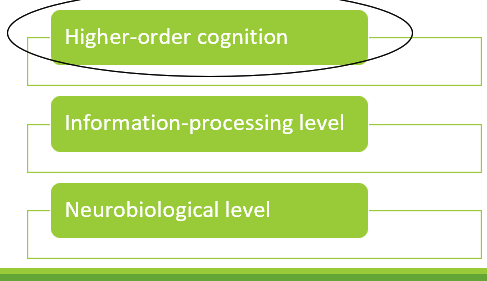
Attributions
inferring the cause of an event
◦Internal vs. external attributions
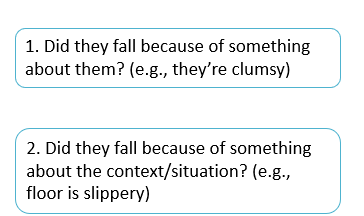
Cognitive bias in depression
In depressed individuals, self-schema encodes unrealistic negative self-beliefs
May be more likely to attribute failures to internal factors and successes to external factors.
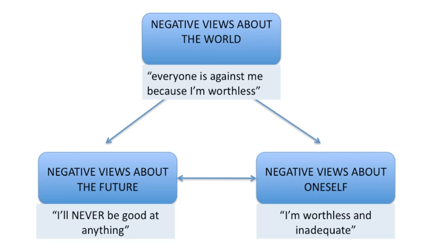
Attributions and decision-making
cognitive therapy: therapeutic technique for changing faulty schemas
cognitive restructuring: challenge automatic negative thoughts and replace with other self-talk
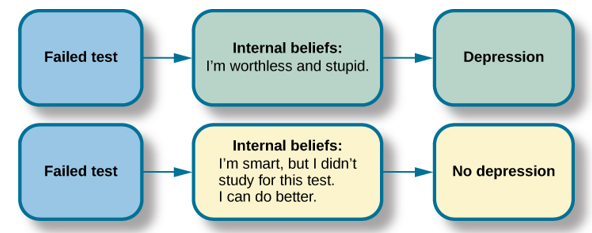
hostile attribution bias
tendency to interpret the behavior of other people as having hostile intentions
Especially when social context cues are ambiguous or unpredictable and difficult to interpret

Mindsets
how stable vs. instable people view their abilities
entity (fixed) mindset
incremental (growth) mindset
entity (fixed) mindset
viewing ability as “fixed”, essentially unchangeable
incremental (growth) mindset
viewing ability as malleable; something that can be growth/improved over time
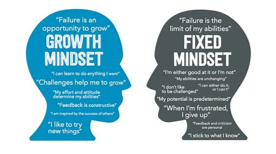
Evaluating the Cognitive Perspective
positives
based on empirical research and supported by data
can potentially integrate information from various perspectives
critiques
is there an over-arching theory?
does it really add anything new to our understanding or personality